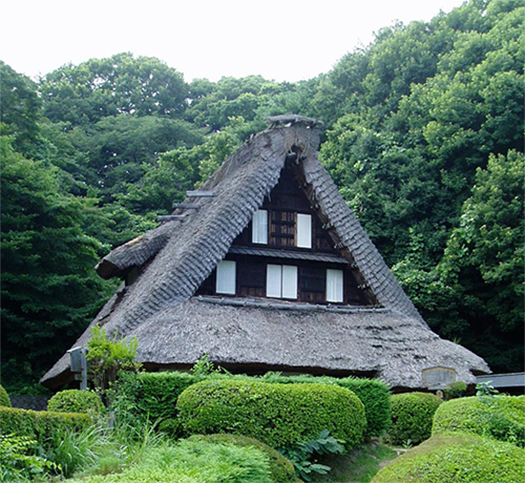

さて、民家と言えば合掌造りと相場が決まっているような刷り込みがある。
なぜなのか、よくわからない部分がある。
全国には固有の住文化を持った古民家があり、それぞれの気候風土対応がある。
沖縄や南島の住文化から、北海道島の竪穴復元住宅まで多種多様。
わたしなどは、北海道の縄文からオホーツク文化などを見続けているので
合掌造りもひとつのパターンとは思うけれど、
イコール古民家、というような感覚は持てない。
たぶん太平洋側文化が主流になって、逆に雪深い山里というイメージが
その三角屋根の美感とともにワンセットで刷り込まれたのか?
いまシリーズで探訪記録を書き続けている川崎の日本民家園でも
このような「合掌造り」建築が3棟立ち並んでいて、
そのうちの1軒は展示住宅のちょうど中間的な位置に建っていることもあり、
またそもそも移築前が合掌造りのおそば屋さんだった、ということから、
店舗として活用までされている。「おお、合掌造りのお店かぁ・・・」
日本民家園という全体景観のなかでももっともポピュラーな存在という刷り込み。
あるいは川崎という立地から、雪深い山国という縁遠さがシンボル化されたか。
この江向家は1階の床面積が50坪を越える。
例によって土間が前面に展開しているけれど、
山岳地域での農業主体の民家では、それほど広い土間はないのだという。
合掌造りの妻入りだけれど、その妻側に下屋が付属しているような形態。
その下屋部分に馬屋と紙すきの作業場となる土間が、
間に壁を仕切って配置されている。
このように入口側が壁重視型の間取りになっているのは、寒冷対策だという。


すぐ上の写真は、その馬屋を右手に見た入口側からの様子。
外観としては妻入りで左右2箇所からの出入りが意図されている。
この土間空間を真ん中で左右に壁が仕切っているのだ。
さらに上写真では馬屋の奥の床板敷空間も壁や板戸で仕切られている。
非常に閉鎖的な造作で、冬期の寒冷への対応が重厚な仕様。
作業場としての土間がそれほど広くないのは、平地の農家住宅と違って
それほどには収穫・生産性が高くないので、作業自体がそう多くないのだと。


紙すきが重要な副業とされていた。
また、板敷きの室内には機織りも展示配置されていた。
農業作業の主体である男性の仕事がそう多くはなく、
かれらは「出稼ぎ」に出ることが多く、留守を預かる女性たちが
家計を支える内職的な仕事として、紙すきや機織りを活発に営んでいたという。
また合掌造りの高い屋根を活かした上階空間では養蚕が行われていた。
それが機織りにも繋がっている。
まことに必死な生活の生業の様子がヒシヒシと伝わってくる。
同じ雪国という北海道人だけれど、雪の「重さ」に違いがあって
軽い北海道の雪とは違った湿度たっぷりの雪質が育む情念を感じさせられる。
English version⬇
[Etchu Gokayama Gassho-zukuri / Emukai Family / Good Japanese House ⑳-1]
By the way, speaking of private houses, there is imprinting that the market price is fixed as well as gassho-zukuri.
I’m not sure why.
There are old folk houses with unique living cultures all over the country, and each has its own climate.
A wide variety of homes, from the living culture of Okinawa and the South Island to the restored pits on Hokkaido Island.
Since I and others continue to see the Okhotsk culture from the Jomon period in Hokkaido,
I think gassho-zukuri is also a pattern,
I can’t feel like an old folk house.
Perhaps the Pacific culture has become mainstream, and on the contrary, the image of a snowy mountain village
Was it imprinted in one set with the beauty of the triangular roof?
Even at the Japanese folk house garden in Kawasaki, which is currently writing exploration records in the series
There are three such “gassho-zukuri” buildings lined up.
One of them may be located just in the middle of the exhibition house,
Also, since it was a gassho-style soba shop before the relocation,
It is even used as a store. “Oh, it’s a gassho-style shop …”
Imprinting that it is the most popular existence in the whole landscape of Japanese folk house garden.
Or was the remoteness of a snowy mountainous country symbolized from the location of Kawasaki?
This Emukai family has a floor area of over 50 tsubo on the first floor.
As usual, the dirt floor is on the front,
It is said that there is not so much soil in a private house that is mainly agricultural in mountainous areas.
It has a gassho-style wife, but it looks like a lower house is attached to the wife’s side.
In the lower part of the house, there is a horse shop and a dirt floor that serves as a papermaking workshop.
It is arranged by partitioning the wall between them.
It is said that the wall-oriented floor plan on the entrance side is a measure against cold weather.
The photo above is from the entrance side when you see the barn on your right.
As for the appearance, it is intended to enter and exit from two places on the left and right with a wife.
A wall divides this dirt space on the left and right in the middle.
Unlike farmhouses on flat land, the soil floor as a work place is not so large.
The productivity of harvesting is not so high, so the work itself is not so much.
Papermaking was regarded as an important side business.
In addition, weaving was also exhibited in the boarded room.
There are not so many men’s jobs that are the main body of agricultural work,
They often go to “migrant workers”, and women who are away from home
It is said that he was actively engaged in papermaking and weaving as an internal job to support the household budget.
In addition, sericulture was carried out in the upper floor space that made use of the high roof of the gassho style.
That also leads to weaving.
The state of the life of a desperate life is transmitted with a rush.
Although they are Hokkaido people who are the same snow country, there is a difference in the “weight” of snow.
You can feel the passion of nurturing the humidity of the snow, which is different from the light snow of Hokkaido.
Posted on 1月 29th, 2021 by 三木 奎吾
Filed under: 住宅マーケティング, 日本社会・文化研究







コメントを投稿
「※誹謗中傷や、悪意のある書き込み、営利目的などのコメントを防ぐために、投稿された全てのコメントは一時的に保留されますのでご了承ください。」
You must be logged in to post a comment.